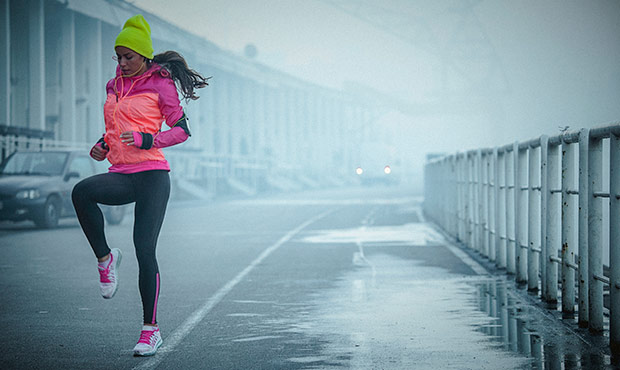
There’s no debating the benefits of exercise. Whether you’re greeted by summer’s heat or winter’s chill, getting at least 30 minutes of physical activity a day is recommended by the CDC, the Surgeon General and the American College of Sports Medicine.
The consensus from this triple threat sends a clear message—no matter the season, it’s important to get up and get moving. As the temperatures drop, you might find yourself spending more time in a brick-and-mortar gym or stuck in a cycle of at-home workouts. But cold weather shouldn’t leave you feeling trapped.
Don’t let winter freeze your outdoor workouts. Check out these tips for dressing for cold-weather exercise.
What to Know About Working Out in the Cold
Before your take on the cold, it’s important to cover the basics. Your first step should be to check the forecast and make a plan.
Snow and frost aren’t the only things you need to be aware of—wind chill is key. A seemingly harmless gust of wind can be enough to penetrate your clothing and remove the insulating layer of warm air that surrounds your body.
When do wind chill extremes make exercising outdoors unsafe regardless of how many layers you’re under? While the risk of frostbite is less than 5 percent when the air temperature is above 5 degrees Fahrenheit, it increases quickly as wind chill falls. It only takes up to 30 minutes to be exposed to frostbite if wind chill drops below -18 degrees Fahrenheit. When the temperatures are less than zero degrees Fahrenheit, consider an indoor workout instead.
Back to Basics: Dressing for the Cold
Once you’ve made sure the wind chill isn’t too low, it’s time to focus on dressing smart. When it comes to outdoor winter exercise, bundling to the max is a mistake. Even in the cold, outdoor exercise will cause you to sweat. Dress in a way that allows you to start off warm and remove articles of clothing as needed. The steps below will help.
1. Base Layer: Polypropylene
Working out in clothing drenched in sweat makes you more vulnerable to the cold and puts your core body temperature at risk of dipping dangerously low.
Having a polypropylene later as your base is a must.
Polypropylene is more commonly known as “moisture-wicking” fabric. As opposed to materials like cotton, which absorb sweat, polypropylene helps sweat evaporate quickly.
Don’t forget about your lower body either. When it’s cold outside, consider wearing a snug later of nylon tights or leggings under your pants to help insulate your legs.
2. Mid Layer: Ventilation
Cover your inner, sweat-wicking layer with another item for insulation. Wearing layers with ample ventilated openings can help to regulate body temperature in colder weather. Opt for items with zippers and mesh sides.
Avoid rubber or plastic-based fabrics that don’t breathe and prevent sweat from evaporating. Fabrics like micro fleece and thermal tops make for a solid middle layer. Consider a mock turtleneck style to protect both your torso and neck.
3. Outer Layer: Element-shielding shell
A nylon jacket or windbreaker made of Gore-Tex works well as a top layer. These rugged, breathable materials help repel wind and water while remaining lightweight and perfect for outdoor movement.
4. Accessories: Protect your extremities.
Make a quick checklist before you leave the house: feet, head and ears, hands and eyes and skin should all be protected before you brave the elements.
Feet: Skip out on the sweat-absorbing cotton, which could lead to moisture, rubbing and blisters, and look for socks made from materials such as drynamix, which pushes moisture away from the skin, and mohair, which keeps your feet warm. Also look for water-resistant, breathable running shoes that make slush, snow and winter’s puddles easier to manage.
Head and Ears:While the myth that you lose most of your heat through your head has been busted, it’s still essential to wear a hat. Look for something polyester and elastane-based to help shield against the wind. When it’s very cold, consider wearing a facemask or wrapping a scarf around your mouth to protect your lungs from the cold air.
Hands: Protect your hands with reflective, moisture-wicking gloves that keep your hands dry and offer added safety for evening workouts. If you exercise with music, consider a pair of gloves that are touch-screen compatible. That way, you don’t have to take off a protective layer every time you want to change a song.
Eyes and Skin: The end of summer doesn’t mean the end of sun. Even in winter, the reflection of UV rays off freshly fallen flakes can be harmful, and the brightness can be blinding. Pack sunglasses and apply sunscreen before you head out.
Winter Workout Clothes FAQs
Is fleece good for working out?
Fleece is light and breathable, making it a good activewear option for colder weather. While it is warm, it doesn’t have the sweat-wicking qualities of other fabrics, so it may not be best as a base layer, however, it does make for a good second layer.
Is it better to workout in cotton or polyester?
Cotton gives off less post-workout stench, however, it holds onto moisture, making it a poor choice for winter workouts. Polyester is more moisture-wicking, which is important when choosing winter workout clothes. Working out in wet clothing in cold weather increases the risk of your core body temperature dropping dangerously low.
Fitness Events Near You
Connect with us on Twitter, Facebook, Instagram or Pinterest for more tips, recipes and ideas to fuel your ACTIVE life.
 Stay in shape in a fitness class or read more fitness articles.
Stay in shape in a fitness class or read more fitness articles.


